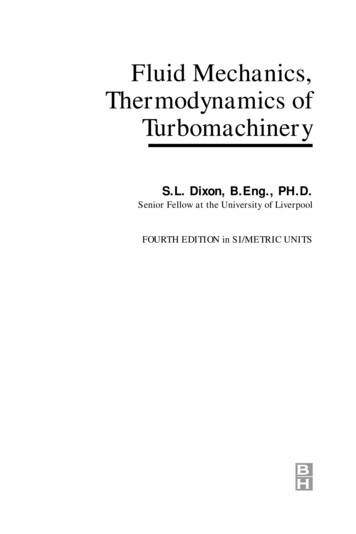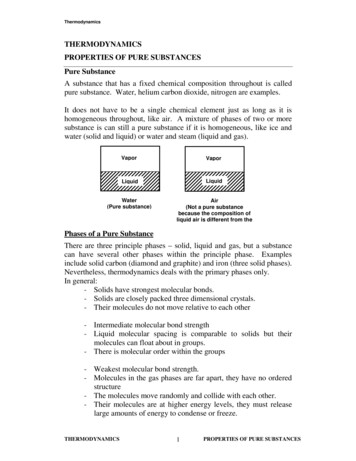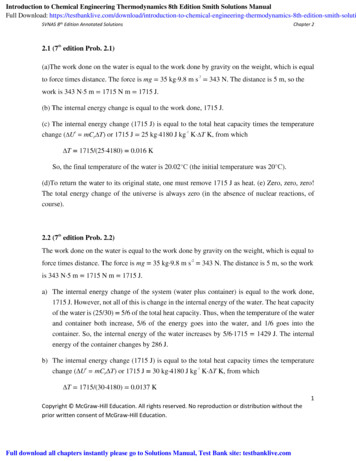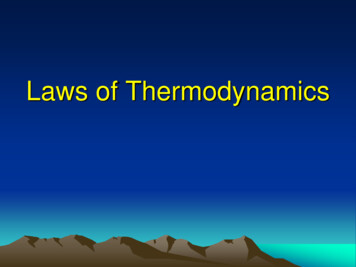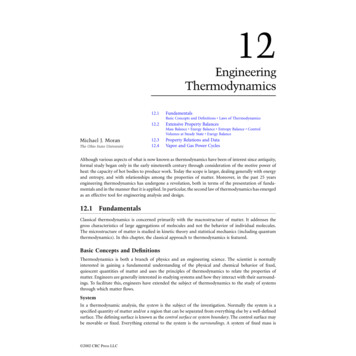
Transcription
12EngineeringThermodynamics12.1FundamentalsBasic Concepts and Definitions Laws of Thermodynamics12.2Extensive Property BalancesMass Balance Energy Balance Entropy Balance ControlVolumes at Steady State Exergy BalanceMichael J. MoranThe Ohio State University12.312.4Property Relations and DataVapor and Gas Power CyclesAlthough various aspects of what is now known as thermodynamics have been of interest since antiquity,formal study began only in the early nineteenth century through consideration of the motive power ofheat: the capacity of hot bodies to produce work. Today the scope is larger, dealing generally with energyand entropy, and with relationships among the properties of matter. Moreover, in the past 25 yearsengineering thermodynamics has undergone a revolution, both in terms of the presentation of fundamentals and in the manner that it is applied. In particular, the second law of thermodynamics has emergedas an effective tool for engineering analysis and design.12.1 FundamentalsClassical thermodynamics is concerned primarily with the macrostructure of matter. It addresses thegross characteristics of large aggregations of molecules and not the behavior of individual molecules.The microstructure of matter is studied in kinetic theory and statistical mechanics (including quantumthermodynamics). In this chapter, the classical approach to thermodynamics is featured.Basic Concepts and DefinitionsThermodynamics is both a branch of physics and an engineering science. The scientist is normallyinterested in gaining a fundamental understanding of the physical and chemical behavior of fixed,quiescent quantities of matter and uses the principles of thermodynamics to relate the properties ofmatter. Engineers are generally interested in studying systems and how they interact with their surroundings. To facilitate this, engineers have extended the subject of thermodynamics to the study of systemsthrough which matter flows.SystemIn a thermodynamic analysis, the system is the subject of the investigation. Normally the system is aspecified quantity of matter and/or a region that can be separated from everything else by a well-definedsurface. The defining surface is known as the control surface or system boundary. The control surface maybe movable or fixed. Everything external to the system is the surroundings. A system of fixed mass is 2002 CRC Press LLC
referred to as a control mass or closed system. When there is flow of mass through the control surface, thesystem is called a control volume or open system. An isolated system is a closed system that does notinteract in any way with its surroundings.State, PropertyThe condition of a system at any instant of time is called its state. The state at a given instant of time isdescribed by the properties of the system. A property is any quantity whose numerical value depends onthe state, but not the history of the system. The value of a property is determined in principle by sometype of physical operation or test.Extensive properties depend on the size or extent of the system. Volume, mass, energy, entropy, andexergy are examples of extensive properties. An extensive property is additive in the sense that its valuefor the whole system equals the sum of the values for its parts. Intensive properties are independent ofthe size or extent of the system. Pressure and temperature are examples of intensive properties.Process, CycleTwo states are identical if, and only if, the properties of the two states are identical. When any propertyof a system changes in value there is a change in state, and the system is said to undergo a process. Whena system in a given initial state goes through a sequence of processes and finally returns to its initial state,it is said to have undergone a thermodynamic cycle.Phase and Pure SubstanceThe term phase refers to a quantity of matter that is homogeneous throughout in both chemical composition and physical structure. Homogeneity in physical structure means that the matter is all solid, orall liquid, or all vapor (or equivalently all gas). A system can contain one or more phases. For example,a system of liquid water and water vapor (steam) contains two phases. A pure substance is one that isuniform and invariable in chemical composition. A pure substance can exist in more than one phase,but its chemical composition must be the same in each phase. For example, if liquid water and watervapor form a system with two phases, the system can be regarded as a pure substance because each phasehas the same composition. The nature of phases that coexist in equilibrium is addressed by the phaserule (for discussion see Moran and Shapiro, 2000).EquilibriumEquilibrium means a condition of balance. In thermodynamics the concept includes not only a balanceof forces, but also a balance of other influences. Each kind of influence refers to a particular aspect ofthermodynamic (complete) equilibrium. Thermal equilibrium refers to an equality of temperature,mechanical equilibrium to an equality of pressure, and phase equilibrium to an equality of chemicalpotentials (for discussion see Moran and Shapiro, 2000). Chemical equilibrium is also established interms of chemical potentials. For complete equilibrium the several types of equilibrium must existindividually.TemperatureA scale of temperature independent of the thermometric substance is called a thermodynamic temperaturescale. The Kelvin scale, a thermodynamic scale, can be elicited from the second law of thermodynamics.The definition of temperature following from the second law is valid over all temperature ranges andprovides an essential connection between the several empirical measures of temperature. In particular,temperatures evaluated using a constant-volume gas thermometer are identical to those of the Kelvin scaleover the range of temperatures where gas thermometry can be used. On the Kelvin scale the unit is thekelvin (K).The Celsius temperature scale (also called the centigrade scale) uses the degree Celsius ( C), whichhas the same magnitude as the kelvin. Thus, temperature differences are identical on both scales.However, the zero point on the Celsius scale is shifted to 273.15 K, the triple point of water (Fig. 12.1b), 2002 CRC Press LLC
as shown by the following relationship between the Celsius temperature and the Kelvin temperature:T( C ) T ( K ) – 273.15(12.1)Two other temperature scales are commonly used in engineering in the U.S. By definition, the Rankinescale, the unit of which is the degree rankine ( R), is proportional to the Kelvin temperature according toT ( R ) 1.8T ( K )(12.2)The Rankine scale is also an absolute thermodynamic scale with an absolute zero that coincides with theabsolute zero of the Kelvin scale. In thermodynamic relationships, temperature is always in terms of theKelvin or Rankine scale unless specifically stated otherwise.A degree of the same size as that on the Rankine scale is used in the Fahrenheit scale, but the zeropoint is shifted according to the relationT ( F ) T ( R ) – 459.67(12.3)Substituting Eqs. (12.1) and (12.2) into Eq. (12.3) givesT ( F ) 1.8T ( C ) 32(12.4)This equation shows that the Fahrenheit temperature of the ice point (0 C) is 32 F and of the steampoint (100 C) is 212 F. The 100 Celsius or Kelvin degrees between the ice point and steam pointcorresponds to 180 Fahrenheit or Rankine degrees.To provide a standard for temperature measurement taking into account both theoretical and practicalconsiderations, the International Temperature Scale of 1990 (ITS-90) is defined in such a way that thetemperature measured on it conforms with the thermodynamic temperature, the unit of which is thekelvin, to within the limits of accuracy of measurement obtainable in 1990. Further discussion of ITS-90is provided by Preston-Thomas (1990).IrreversibilitiesA process is said to be reversible if it is possible for its effects to be eradicated in the sense that there issome way by which both the system and its surroundings can be exactly restored to their respective initialstates. A process is irreversible if both the system and surroundings cannot be restored to their initial states.There are many effects whose presence during a process renders it irreversible. These include, but arenot limited to, the following: heat transfer through a finite temperature difference; unrestrained expansionof a gas or liquid to a lower pressure; spontaneous chemical reaction; mixing of matter at differentcompositions or states; friction (sliding friction as well as friction in the flow of fluids); electric currentflow through a resistance; magnetization or polarization with hysteresis; and inelastic deformation.The term irreversibility is used to identify effects such as these.Irreversibilities can be divided into two classes, internal and external. Internal irreversibilities are thosethat occur within the system, while external irreversibilities are those that occur within the surroundings,normally the immediate surroundings. As this division depends on the location of the boundary thereis some arbitrariness in the classification (by locating the boundary to take in the immediate surroundings,all irreversibilities are internal). Nonetheless, valuable insights can result when this distinction betweenirreversibilities is made. When internal irreversibilities are absent during a process, the process is said tobe internally reversible. At every intermediate state of an internally reversible process of a closed system,all intensive properties are uniform throughout each phase present: the temperature, pressure, specificvolume, and other intensive properties do not vary with position. 2002 CRC Press LLC
Laws of ThermodynamicsThe first steps in a thermodynamic analysis are definition of the system and identification of the relevantinteractions with the surroundings. Attention then turns to the pertinent physical laws and relationshipsthat allow the behavior of the system to be described in terms of an engineering model, which is asimplified representation of system behavior that is sufficiently faithful for the purpose of the analysis,even if features exhibited by the actual system are ignored.Thermodynamic analyses of control volumes and closed systems typically use, directly or indirectly,one or more of three basic laws. The laws, which are independent of the particular substance or substancesunder consideration, are the conservation of mass principle, the conservation of energy principle, the second law of thermodynamics.The second law may be expressed in terms of entropy or exergy.The laws of thermodynamics must be supplemented by appropriate thermodynamic property data.For some applications a momentum equation expressing Newton’s second law of motion also is required.Data for transport properties, heat transfer coefficients, and friction factors often are needed for a comprehensive engineering analysis. Principles of engineering economics and pertinent economic data also canplay prominent roles.12.2 Extensive Property BalancesThe laws of thermodynamics can be expressed in terms of extensive property balances for mass, energy,entropy, and exergy. Engineering applications are generally analyzed on a control volume basis. Accordingly, the control volume formulations of the mass energy, entropy, and exergy balances are featuredhere. They are provided in the form of overall balances assuming one-dimensional flow. Equations ofchange for mass, energy, and entropy in the form of differential equations are also available in the literature(Bird et al., 1960).Mass BalanceFor applications in which inward and outward flows occur, each through one or more ports, the extensiveproperty balance expressing the conservation of mass principle takes the formdm-------- dt ṁ – ṁie(12.5)eiwhere dm/dt represents the time rate of change of mass contained within the control volume, ṁi denotesthe mass flow rate at an inlet port, and ṁ e denotes the mass flow rate at an exit port.The volumetric flow rate through a portion of the control surface with area dA is the product of thevelocity component normal to the area, vn, times the area: vndA. The mass flow rate through dA is ρ(vndA),where ρ denotes density. The mass rate of flow through a port of area A is then found by integrationover the areaṁ Aρvn dAFor one-dimensional flow the intensive properties are uniform with position over area A, and the lastequation becomesvAṁ ρvA -----v 2002 CRC Press LLC(12.6)
0066 frame C12 Page 5 Wednesday, January 9, 2002 4:22 PMwhere v denotes the specific volume (the reciprocal of density) and the subscript n has been droppedfrom velocity for simplicity.Energy BalanceEnergy is a fundamental concept of thermodynamics and one of the most significant aspects of engineering analysis. Energy can be stored within systems in various macroscopic forms: kinetic energy,gravitational potential energy, and internal energy. Energy also can be transformed from one form toanother and transferred between systems. Energy can be transferred by work, by heat transfer, and byflowing matter. The total amount of energy is conserved in all transformations and transfers. The extensiveproperty balance expressing the conservation of energy principle takes the formd ( U KE PE )--------------------------------------- Q̇ – Ẇ dt i2vṁi h i ----i gz i – 2 e2vṁe h e ----e gz e 2(12.7a)where U, KE, and PE denote, respectively, the internal energy, kinetic energy, and gravitational potentialenergy of the overall control volume.The right side of Eq. (12.7a) accounts for transfers of energy across the boundary of the control volume.Energy can enter and exit control volumes by work. Because work is done on or by a control volumewhen matter flows across the boundary, it is convenient to separate the work rate (or power) into twocontributions. One contribution is the work rate associated with the force of the fluid pressure as massis introduced at the inlet and removed at the exit. Commonly referred to as flow work, this contributionis accounted for by ṁi (p i v i ) and ṁe (p e v e ), respectively, where p denotes pressure and v denotes specificvolume. The other contribution, denoted by Ẇ in Eq. (12.7a), includes all other work effects, such asthose associated with rotating shafts, displacement of the boundary, and electrical effects. Ẇ is consideredpositive for energy transfer from the control volume.Energy also can enter and exit control volumes with flowing streams of matter. On a one-dimensional2flow basis, the rate at which energy enters with matter at inlet i is ṁi (u i v i /2 gz i ), where the threeterms in parentheses account, respectively, for the specific internal energy, specific kinetic energy, andspecific gravitational potential energy of the substance flowing through port i. In writing Eq. (12.7a) thesum of the specific internal energy and specific flow work at each inlet and exit is expressed in terms ofthe specific enthalpy h( u pv). Finally, Q̇ accounts for the rate of energy transfer by heat and isconsidered positive for energy transfer to the control volume.By dropping the terms of Eq. (12.7a) involving mass flow rates an energy rate balance for closedsystems is obtained. In principle the closed system energy rate balance can be integrated for a processbetween two states to give the closed system energy balance:( U 2 – U 1 ) ( KE 2 – KE 1 ) ( PE 2 – PE 1 ) Q – W(closed systems)(12.7b)where 1 and 2 denote the end states. Q and W denote the amounts of energy transferred by heat andwork during the process, respectively.Entropy BalanceContemporary applications of engineering thermodynamics express the second law, alternatively, as anentropy balance or an exergy balance. The entropy balance is considered here.Like mass and energy, entropy can be stored within systems and transferred across system boundaries.However, unlike mass and energy, entropy is not conserved, but generated (or produced) by irreversibilities 2002 CRC Press LLC
0066 frame C12 Page 6 Wednesday, January 9, 2002 4:22 PMwithin systems. A control volume form of the extensive property balance for entropy isdS------ dtQ̇ j ----T- ṁ s – ṁ si ijje ei Ṡ gen(12.8)e------------------------------ ---rates of entropytransferrate of entropygenerationwhere dS/dt represents the time rate of change of entropy within the control volume. The terms ṁi s iand ṁ e s e account, respectively, for rates of entropy transfer into and out of the control volume accompanying mass flow. Q̇ j represents the time rate of heat transfer at the location on the boundary wherethe instantaneous temperature is Tj, and Q̇ j /T j accounts for the accompanying rate of entropy transfer.Ṡ gen denotes the time rate of entropy generation due to irreversibilities within the control volume. Anentropy rate balance for closed systems is obtained by dropping the terms of Eq. (12.8) involving massflow rates.When applying the entropy balance in any of its forms, the objective is often to evaluate the entropygeneration term. However, the value of the entropy generation for a given process of a system usuallydoes not have much significance by itself. The significance normally is determined through comparison:the entropy generation within a given component would be compared with the entropy generation valuesof the other components included in an overall system formed by these components. This allows theprincipal contributors to the irreversibility of the overall system to be pinpointed.Control Volumes at Steady StateEngineering systems are often idealized as being at steady state, meaning that all properties are unchangingin time. For a control volume at steady state, the identity of the matter within the control volume changescontinuously, but the total amount of mass remains constant. At steady state, the mass rate balanceEq. (12.5) reduces to ṁ ii ṁ(12.9a)eeAt steady state, the energy rate balance Eq. (12.7a) becomes20 Q̇ – Ẇ vi ṁ h ---2- gz – ṁ hiieiei2ev ----e gz e 2(12.9b)At steady state, the entropy rate balance Eq. (12.8) reads0 Q̇ j ----T- ṁ s – ṁ si ijjie e Ṡ gen(12.9c)eMass and energy are conserved quantities, but entropy is not generally conserved. Equation (12.9a)indicates that the total rate of mass flow into the control volume equals the total rate of mass flow outof the control volume. Similarly, Eq. (12.9b) states that the total rate of energy transfer into the controlvolume equals the total rate of energy transfer out of the control volume. However, Eq. (12.9c) showsthat the rate at which entropy is transferred out exceeds the rate at which entropy enters, the differencebeing the rate of entropy generation within the control volume owing to irreversibilities.Many applications involve control volumes having a single inlet and a single exit. For such casesthe mass rate balance, Eq. (12.9a), reduces to ṁ i ṁ e . Denoting the common mass flow rate by ṁ, 2002 CRC Press LLC
0066 frame C12 Page 7 Wednesday, January 9, 2002 4:22 PMEqs. (12.9b) and (12.9c) give, respectively,22vi – ve - g ( zi – ze )0 Q̇ – Ẇ ṁ ( h i – h e ) ------------- 2 (12.10a)Q̇0 ----- ṁ ( s i – s e ) Ṡ genTb(12.11a)where for simplicity Tb denotes the temperature, or a suitable average temperature, on the boundarywhere heat transfer occurs.When energy and entropy rate balances are applied to particular cases of interest, additional simplifications are usually made. The heat transfer term Q̇ is dropped when it is insignificant relative to otherenergy transfers across the boundary. This may be the result of one or more of the following: (1) the outersurface of the control volume is insulated; (2) the outer surface area is too small for there to be effectiveheat transfer; (3) the temperature difference between the control volume and its surroundings is smallenough that the heat transfer can be ignored; (4) the gas or liquid passes through the control volume soquickly that there is not enough time for significant heat transfer to occur. The work term Ẇ drops outof the energy rate balance when there are no rotating shafts, displacements of the boundary, electricaleffects, or other work mechanisms associated with the control volume being considered. The effects ofkinetic and potential energy are frequently negligible relative to other terms of the energy rate balance.The special forms of Eqs. (12.10a) and (12.11a) listed in Table 12.1 are obtained as follows: Whenthere is no heat transfer, Eq. (12.11a) givesṠ gen- 0s e – s i ------ṁ(12.11b)(no heat transfer)Accordingly, when irreversibilities are present within the control volume, the specific entropy increasesas mass flows from inlet to outlet. In the ideal case in which no internal irreversibilities are present, masspasses through the control volume with no change in its entropy—that is, isentropically.For no heat transfer, Eq. (12.10a) gives22vi – ve - g ( zi – ze )Ẇ ṁ ( h i – h e ) ------------- 2 (12.10b)( no heat transfer )A special form that is applicable, at least approximately, to compressors, pumps, and turbines resultsfrom dropping the kinetic and potential energy terms of Eq. (12.10b), leavingẆ ṁ ( h i – h e )( compressors, pumps, and turbines )(12.10c)In throttling devices a significant reduction in pressure is achieved by introducing a restriction into a linethrough which a gas or liquid flows. For such devices Ẇ 0 and Eq. (12.10c) reduces further to readhi he( throttling process )That is, upstream and downstream of the throttling device, the specific enthalpies are equal. 2002 CRC Press LLC(12.10d)
0066 frame C12 Page 8 Wednesday, January 9, 2002 4:22 PMTABLE 12.1 Energy and Entropy Balances for One-Inlet, One-Outlet ControlVolumes at Steady State and No Heat TransferEnergy balance22vi – ve - g ( zi – ze )Ẇ ṁ ( h i – h e ) ------------- 2 Compressors, pumps, and turbines(12.10b)aẆ ṁ ( h i – h e )(12.10c)he hi(12.10d)vi 2 ( hi – he )(12.10e)ThrottlingNozzles, diffusersbve 2Entropy balanceṠ gen- 0s e – s i ------ṁ(12.11b)aFor an ideal gas with constant cp , Eq. (1′) of Table 12.4 allows Eq. (12.10c) tobe written as(12.10c′)Ẇ ṁc p ( T i – T e )The power developed in an isentropic process is obtained with Eq. (5′) of Table 12.4 as( k 1 )/k] (s c)Ẇ ṁc p T i [ 1 – ( p e /p i )(12.10c′′)where cp kR/(k 1).bFor an ideal gas with constant cp, Eq. (1′) of Table 12.4 allows Eq. (12.10e) to bewritten as2(12.10e′)v e v i 2c p ( T i – T e )The exit velocity for an isentropic process is obtained with Eq. (5′) of Table 12.4 asve v i 2c p T i [ 1 – ( p e /p i )2( k – 1 )/k] (s c)where cp kR/(k 1).(12.10e′′)A nozzle is a flow passage of varying cross-sectional area in which the velocity of a gas or liquid increases in the direction of flow. In a diffuser, the gas or liquid decelerates in the direction of flow. For suchdevices, Ẇ 0. The heat transfer and potential energy change are generally negligible. Then Eq.(12.10b) reduces to22vi – ve0 h i – h e -------------2Solving for the exit velocityve 2vi 2 ( hi – he )(12.10e)( nozzle, diffuser )The steady-state forms of the mass, energy, and entropy rate balances can be applied to control volumeswith multiple inlets and/or exits, for example, cases involving heat-recovery steam generators, feedwaterheaters, and counterflow and crossflow heat exchangers. Transient (or unsteady) analyses can be conducted with Eqs. (12.5), (12.7a), and (12.8). Illustrations of all such applications are provided by Moranand Shapiro (2000). 2002 CRC Press LLC
0066 frame C12 Page 9 Wednesday, January 9, 2002 4:22 PMExergy BalanceExergy provides an alternative to entropy for applying the second law. When exergy concepts are combinedwith principles of engineering economy, the result is known as thermoeconomics. Thermoeconomics allowsthe real cost sources to be identified: capital investment costs, operating and maintenance costs, and thecosts associated with the destruction and loss of exergy. Optimization of systems can be achieved by acareful consideration of such cost sources. From this perspective thermoeconomics is exergy-aided costminimization. Discussions of exergy analysis and thermoeconomics are provided by Moran (1989), Bejanet al. (1996), Moran and Tsatsaronis (2000), and Moran and Shapiro (2000). In this section salient aspectsare presented.Defining ExergyAn opportunity for doing work exists whenever two systems at different states are placed in communicationbecause, in principle, work can be developed as the two are allowed to come into equilibrium. When oneof the two systems is a suitably idealized system called an environment and the other is some system ofinterest, exergy is the maximum theoretical useful work (shaft work or electrical work) obtainable as thesystem of interest and environment interact to equilibrium, heat transfer occurring with the environmentonly. (Alternatively, exergy is the minimum theoretical useful work required to form a quantity of matterfrom substances present in the environment and bring the matter to a specified state.) Exergy is a measureof the departure of the state of the system from that of the environment, and is therefore an attribute ofthe system and environment together. Once the environment is specified, however, a value can be assignedto exergy in terms of property values for the system only, so exergy can be regarded as an extensive propertyof the system. Exergy can be destroyed and, like entropy, generally is not conserved.Models with various levels of specificity are employed for describing the environment used to evaluateexergy. Models of the environment typically refer to some portion of a system’s surroundings, the intensiveproperties of each phase of which are uniform and do not change significantly as a result of any processunder consideration. The environment is regarded as composed of common substances existing in abundance within the Earth’s atmosphere, oceans, and crust. The substances are in their stable forms as theyexist naturally, and there is no possibility of developing work from interactions—physical or chemical—between parts of the environment. Although the intensive properties of the environment are assumed tobe unchanging, the extensive properties can change as a result of interactions with other systems. Kineticand potential energies are evaluated relative to coordinates in the environment, all parts of which areconsidered to be at rest with respect to one another. For computational ease, the temperature T0 andpressure p0 of the environment are often taken as typical ambient values, such as 1 atm and 25 C (77 F).However, these properties may be specified differently depending on the application.When a system is in equilibrium with the environment, the state of the system is called the dead state.At the dead state, the conditions of mechanical, thermal, and chemical equilibrium between the systemand the environment are satisfied: the pressure, temperature, and chemical potentials of the system equalthose of the environment, respectively. In addition, the system has no motion or elevation relative tocoordinates in the environment. Under these conditions, there is no possibility of a spontaneous changewithin the system or the environment, nor can there be an interaction between them. The value of exergyis zero. Another type of equilibrium between the system and environment can be identified. This is arestricted form of equilibrium where only the conditions of mechanical and thermal equilibrium mustbe satisfied. This state of the system is called the restricted dead state. At the restricted dead state, thefixed quantity of matter under consideration is imagined to be sealed in an envelope impervious to massflow, at zero velocity and elevation relative to coordinates in the environment, and at the temperatureT0 and pressure p0.Exergy Transfer and Exergy DestructionExergy can be transferred by three means: exergy transfer associated with work, exergy transfer associatedwith heat transfer, and exergy transfer associated with the matter entering and exiting a control volume.All such exergy transfers are evaluated relative to the environment used to define exergy. Exergy also is 2002 CRC Press LLC
0066 frame C12 Page 10 Wednesday, January 9, 2002 4:22 PMdestroyed by irreversibilities within the system or control volume. Exergy balances can be written invarious forms, depending on whether a closed system or control volume is under consideration andwhether steady-state or transient operation is of interest. Owing to its importance for a wide range ofapplications, an exergy rate balance for control volumes at steady state is presented alternatively asEqs. (12.12a) and (12.12b).0 Ėq, j– Ẇ j Ė – Ėiie– Ė D(12.12a)e------------------------------- --rates ofexergytransfer0 T0rate ofexergydestruction 1 – ----T- Q̇ – Ẇ ṁ e – ṁ ejijje eii– Ė D(12.12b)eẆ has the same significance as in Eq. (12.7a): the work rate excluding the flow work. Q̇ j is the time rate ofheat transfer at the location on the boundary of the control volume where the instantaneous temperatureis Tj . The associated rate of exergy transfer isTĖ q, j 1 – -----0 Q̇ j Tj (12.13)As for other control volume rate balances, the subscripts i and e denote inlets and exits, respectively. Theexergy transfer rates at control volume inlets and exits are denoted, respectively, as Ė i ṁ i e i andĖ e ṁ e e e . Finally, Ė D accounts for the time rate of exergy destruction due to irreversibilities withinthe control volume. The exergy destruction rate is related to the entropy generation rate byĖ D T 0 Ṡ gen(12.14)The specific exergy transfer terms ei and ee are expressible in terms of four components: physical exergyPHKNPTCHe , kinetic exergy e , potential exergy e
engineering thermodynamics has undergone a revolution, both in terms of the presentation of funda-mentals and in the manner that it is applied. In particular, the second law of thermodynamics has emerged as an effective tool for engineering analysis and design. 12.1 Fundamentals




